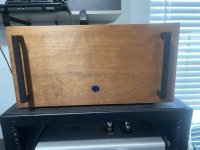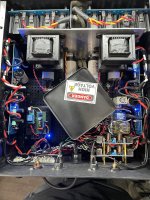Congratulations for the 10 000:th Aleph J post!
🙂
Regarding resistors: I do not know, since i have not A/B listening tested resistors yet.
I am planning to do a A/B- test some day: The resistor in the passive crossover for the tweeters or the compression drivers seems to be good candidates, and very easy to switch. 🥁🎺🙂🎸🎷
🙂
Regarding resistors: I do not know, since i have not A/B listening tested resistors yet.
I am planning to do a A/B- test some day: The resistor in the passive crossover for the tweeters or the compression drivers seems to be good candidates, and very easy to switch. 🥁🎺🙂🎸🎷
https://www.diyaudio.com/community/...ated-build-guide.241729/page-489#post-7560419What are the key parts for Aleph J that are worth upgrading beyond the standard BOM?
Concentrate on R1, R2, R3, R4 and R24 and associated caps in the direct signal path?
I’m thinking of using s/z-foils - to try and inject some additional openness and move even more towards the speed/fire of tube amps if that is a plausible aim.
HI , can I know the carbon films you like is?I was on holiday for a few weeks, so I had a day here and there I could spend on my hobby. So, logically, I looked at the Aleph J schematics again and considered what else I could do to improve the sound even further. The things I've done so far were a bypass of C1 with a copper link, removing a short circuit protection transistor and associated voltage divider resistors, and the work I put into decoupling power supply rails with polypropylene film caps and my favourite Black Gate N-type caps.
So, I kept looking at the schematics diagram hoping the Muse would strike... and then I realised that 2k trimpot that sets DC offset should be treated the same way as I/V reisistor in current-out DACs. What I had there before the mod, was a Bourns 2k trimpot, but I decided to find a suitable discrete resistor replacement to see what would happen with the sound. The more I looked at it, the more I wondered how the hell I didn't realise the importance of that 2k resistor before...?
So, I ended up using my favourite graphite film resistors, 1.2K each, 0.25W. And the result was mind-boggling. My kids thought that I bought a brand-new amplifier. What stood out was the speed, extension at both ends... and in particular the top-end extension in "all directions".
The resistor choice (carbon, metal film, Rhopoint (could be inductive!), TX2352, Holco...) would depend on your personal listening preferences and definitely on the rest of your system. I remember achieving very good I/V results with TX2352s, and TDA1541 / DDDACs... but in the case of Aleph J, the carbon films worked best for me.
So, if you do not have better things to do this 2024, put the above mod at the top of your list (of improvements).
I used Allen Bradley 1.3K 1/2W carbon resistors.
Then I tried TX2352, but settled on Allen Bradley in the end.
Removing the trim pot from that position in the direct sound chain is the biggest sound improvement.... the resistor types provide fine sound-tunning options.
Then I tried TX2352, but settled on Allen Bradley in the end.
Removing the trim pot from that position in the direct sound chain is the biggest sound improvement.... the resistor types provide fine sound-tunning options.
Adjust the bias and DC offset to what you want, then measure the trim-pot resistance. You need two resistors.
Side note: Texas Components will "cut" the excellent-sounding TX2352 to the exact resistance you need. Just ask them via e-mail.
Side note: Texas Components will "cut" the excellent-sounding TX2352 to the exact resistance you need. Just ask them via e-mail.
Is there a required quantity to place an order? I guess I should find their Web site and check them out.
If they do that small quantity that is one heck of a service. If necessary, I could bulk up the order with a bunch of commonly used values.
Russellc
If they do that small quantity that is one heck of a service. If necessary, I could bulk up the order with a bunch of commonly used values.
Russellc
Holy crap. No quantity required! Right on front page. Think I have a new source for resistors!
That's incredible!!!Texas Components will "cut" the excellent-sounding TX2352 to the exact resistance you need
Its no big deal, just solder in resistor. I see that advice more than one time to replace pot with resistor. Seems like there is a recommended value to use from the get go.This is very interesting but perhaps more advanced than me at this time. Wouldn't you need to measure your individual unit to arrive at the appropriate resistor value?
I have not replaced the pot yet! 😕 It's been totally reliable, hasn't been a reason to work on it.
I would have to use the "measure the pot" method for best sleep.
Russellc
My pot is still in place after 6l6 original group buy! It sounds fine. Everyone always says it sounds better with resistor, so interesting 🤔
Sounds pretty straight forward, what did your actual measurement indicate for ideal resistance?Adjust the bias and DC offset to what you want, then measure the trim-pot resistance.
Basically your pot IS a resistor. It's just variable is all. Once set, measure across it to see what it measures in resistance. Replace with resistor of that value. Again, I am being Mr big mouth and I haven't done this yet!
IIRC in this build guide it covers it, suggesting using a fixed resistor of a certain value. May be in the banter afterwards, not actual "guide" part.
Apologies if this is wrong and info is elsewhere....it was (and still is) a popular build at the time and I read a ton of stuff back then.
Russellc
Apologies if this is wrong and info is elsewhere....it was (and still is) a popular build at the time and I read a ton of stuff back then.
Russellc
My R7 resistance values were 1450 and 1380 ohms... or 1350 and 1280... I can not remember exactly.
The quiescent current is set at 490 mV (on power up, cold) which drops to 460 mV once the amp reaches its nominal temperature. The case is deluxe 5U; the transformer is 400VA, with a 2 x 20V AC secondary voltage. My rails are around 24.5V DC loaded.
C1s are removed/bypassed with copper links; the short circuit protection transistors Q3 (and associated voltage divider resistors R13 & R14) are removed.
The power supply has additional DC-rails decoupling caps: Wima pp film 0.01uF / 50V and bipolar Black Gate N-type 100uF / 50V.
The R7 trim-pots substitute with discrete resistors was the best upgrade sound-wise.
Installing/soldering the socket pins, to allow for different resistor types, is probably an excellent idea. I'll do that next.... I like Allen Bradley's natural ease of presentation, but the TX2352 precision and "factor-zero colouring" is also nice... The choice would purely depend on the quality of the material/files being played... I settled on Allan Bradley in the end. That was a very hard decision to make.
The quiescent current is set at 490 mV (on power up, cold) which drops to 460 mV once the amp reaches its nominal temperature. The case is deluxe 5U; the transformer is 400VA, with a 2 x 20V AC secondary voltage. My rails are around 24.5V DC loaded.
C1s are removed/bypassed with copper links; the short circuit protection transistors Q3 (and associated voltage divider resistors R13 & R14) are removed.
The power supply has additional DC-rails decoupling caps: Wima pp film 0.01uF / 50V and bipolar Black Gate N-type 100uF / 50V.
The R7 trim-pots substitute with discrete resistors was the best upgrade sound-wise.
Installing/soldering the socket pins, to allow for different resistor types, is probably an excellent idea. I'll do that next.... I like Allen Bradley's natural ease of presentation, but the TX2352 precision and "factor-zero colouring" is also nice... The choice would purely depend on the quality of the material/files being played... I settled on Allan Bradley in the end. That was a very hard decision to make.
Well since I posted to the wrong thread yesterday (original needs deleted) I thought I'd try
again here. Amp is full mono except for power cord. PS is CLC bypassed w/motor run caps.
Under the cover is 2 Antek 200W 18V x-formers. It adjusted easily and now has probably 12
hours on it. It's also the quietest amp I've built bar none.
again here. Amp is full mono except for power cord. PS is CLC bypassed w/motor run caps.
Under the cover is 2 Antek 200W 18V x-formers. It adjusted easily and now has probably 12
hours on it. It's also the quietest amp I've built bar none.
Attachments
- Home
- Amplifiers
- Pass Labs
- Aleph J illustrated build guide


